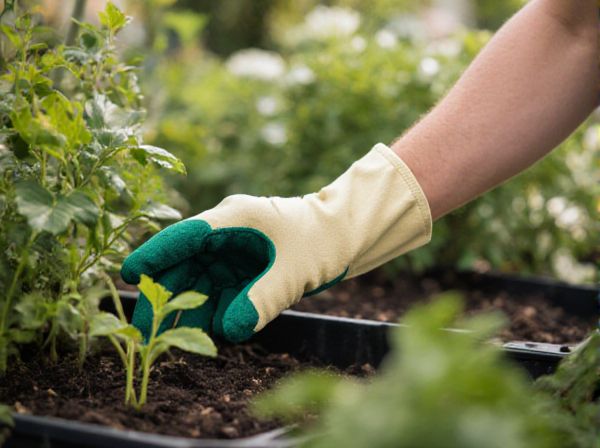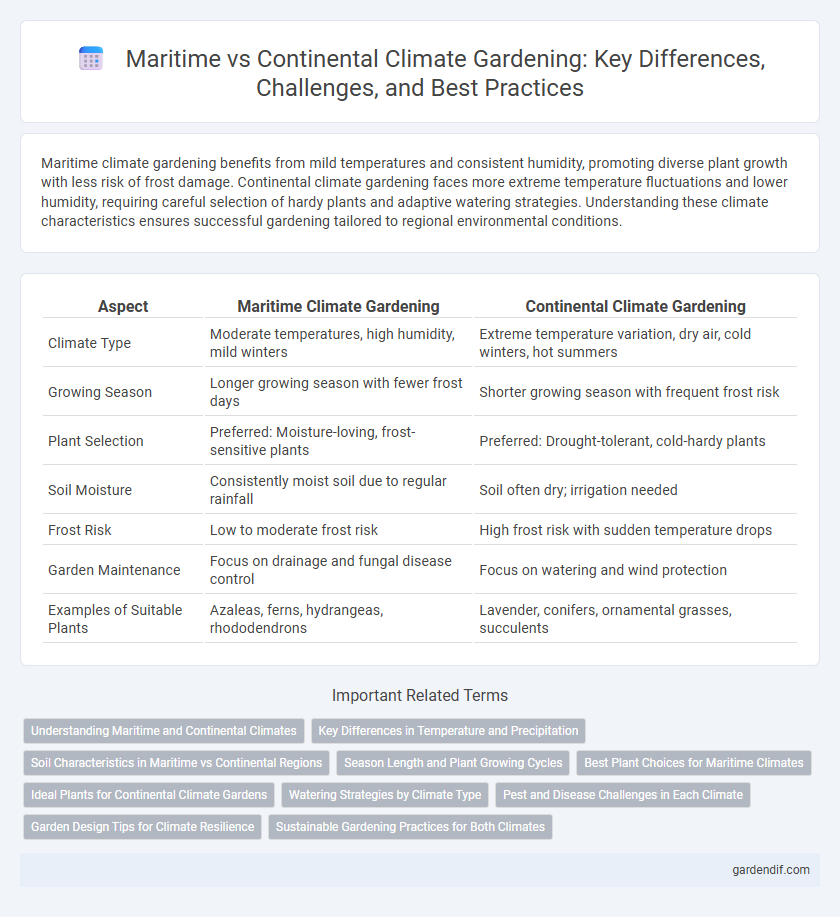
Maritime Climate Gardening vs Continental Climate Gardening Illustration
Maritime climate gardening benefits from mild temperatures and consistent humidity, promoting diverse plant growth with less risk of frost damage. Continental climate gardening faces more extreme temperature fluctuations and lower humidity, requiring careful selection of hardy plants and adaptive watering strategies. Understanding these climate characteristics ensures successful gardening tailored to regional environmental conditions.
Table of Comparison
| Aspect | Maritime Climate Gardening | Continental Climate Gardening |
|---|---|---|
| Climate Type | Moderate temperatures, high humidity, mild winters | Extreme temperature variation, dry air, cold winters, hot summers |
| Growing Season | Longer growing season with fewer frost days | Shorter growing season with frequent frost risk |
| Plant Selection | Preferred: Moisture-loving, frost-sensitive plants | Preferred: Drought-tolerant, cold-hardy plants |
| Soil Moisture | Consistently moist soil due to regular rainfall | Soil often dry; irrigation needed |
| Frost Risk | Low to moderate frost risk | High frost risk with sudden temperature drops |
| Garden Maintenance | Focus on drainage and fungal disease control | Focus on watering and wind protection |
| Examples of Suitable Plants | Azaleas, ferns, hydrangeas, rhododendrons | Lavender, conifers, ornamental grasses, succulents |
Understanding Maritime and Continental Climates
Maritime climate gardening thrives in mild, humid conditions with moderate temperature fluctuations, ideal for cultivating moisture-loving plants and extending growing seasons. Continental climate gardening requires selecting hardy, drought-resistant species adapted to extreme temperature variations and lower humidity levels typical of inland regions. Understanding temperature ranges, precipitation patterns, and frost dates is essential for optimizing plant growth and garden productivity in these contrasting climates.
Key Differences in Temperature and Precipitation
Maritime climate gardening benefits from mild temperatures and consistent precipitation due to proximity to large bodies of water, resulting in less temperature fluctuation and higher humidity levels. In contrast, continental climate gardening experiences more extreme temperature variations between seasons and lower, less reliable precipitation, requiring plants to adapt to drought stress and frost. These key differences influence plant selection, irrigation practices, and growing season length in each gardening environment.
Soil Characteristics in Maritime vs Continental Regions
Maritime climate gardening benefits from soil with higher organic matter content and better moisture retention due to consistent humidity and moderate temperatures. In contrast, continental climate soils tend to be drier and more prone to nutrient depletion because of extreme temperature variations and lower precipitation. Gardeners in maritime regions can exploit richer, loamier soils, while those in continental zones must often amend soil with organic materials to improve fertility and water-holding capacity.
Season Length and Plant Growing Cycles
Maritime climate gardening benefits from mild temperatures and extended growing seasons, often allowing multiple planting cycles due to minimal frost risk and consistent moisture. Continental climate gardening faces shorter growing seasons with distinct frost dates, requiring careful timing to optimize plant growth within limited frost-free days. Understanding these seasonal variations is crucial for selecting appropriate crop varieties and maximizing yield in each climate zone.
Best Plant Choices for Maritime Climates
Best plant choices for maritime climates include salt-tolerant species like lavender, rosemary, and hydrangeas, which thrive in mild, moist conditions with minimal temperature fluctuations. Coastal shrubs such as sea buckthorn and beach rose offer resilience to salty winds and sandy soils common in maritime gardening zones. Perennials like hellebores and ferns also flourish, benefiting from the consistent humidity and moderate winters characteristic of maritime climates.
Ideal Plants for Continental Climate Gardens
Continental climate gardening favors plants that tolerate temperature extremes and shorter growing seasons, such as conifers, maples, and hardy perennials like asters and black-eyed Susans. These plants exhibit strong cold resistance and adapt to dry, fluctuating conditions typical of inland regions. Selecting drought-tolerant species and deciduous shrubs ensures vibrant seasonal changes and resilience in continental gardens.
Watering Strategies by Climate Type
Maritime climate gardening benefits from frequent, moderate watering due to higher humidity and consistent rainfall, reducing water stress on plants. In contrast, continental climate gardening requires deeper, less frequent watering to counteract lower humidity, greater temperature fluctuations, and rapid soil moisture evaporation. Optimizing watering schedules by climate type enhances plant health and conserves water resources effectively.
Pest and Disease Challenges in Each Climate
Maritime climate gardening often faces persistent humidity and mild temperatures that foster fungal diseases and mold, requiring vigilant monitoring and frequent use of fungicides. Continental climate gardening encounters more extreme temperature variations, which can stress plants and increase vulnerability to pests like aphids and spider mites during hot summers and viral infections during cold winters. Effective pest and disease management in each climate depends on tailored strategies that address specific local conditions and seasonal challenges.
Garden Design Tips for Climate Resilience
Maritime climate gardening benefits from consistent moisture and moderate temperatures, favoring plants like hydrangeas and ferns that thrive in humidity and mild seasonal changes. Continental climate gardening requires selecting drought-resistant and frost-hardy species such as conifers and perennial grasses to withstand temperature extremes and variable precipitation. Incorporating raised beds, mulching, and windbreaks enhances soil moisture retention and protects plants from harsh winds, boosting garden resilience in both climate types.
Sustainable Gardening Practices for Both Climates
Sustainable gardening practices in maritime climates prioritize moisture retention, salt-tolerant plant species, and windbreaks to combat salty air and consistent humidity, enhancing soil health and reducing water use. In continental climates, sustainable gardening emphasizes drought-resistant plants, mulching, and efficient irrigation systems to withstand temperature extremes and prevent soil erosion. Both climate-specific strategies focus on organic composting, native plant integration, and minimal chemical inputs to promote biodiversity and long-term ecosystem stability.
Maritime Climate Gardening vs Continental Climate Gardening Infographic

 gardendif.com
gardendif.com